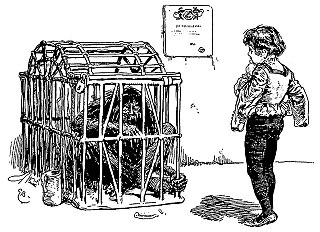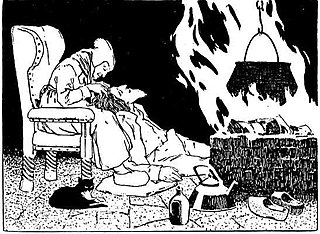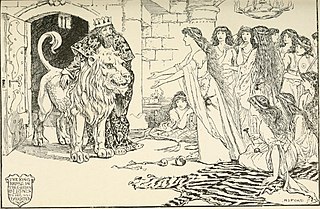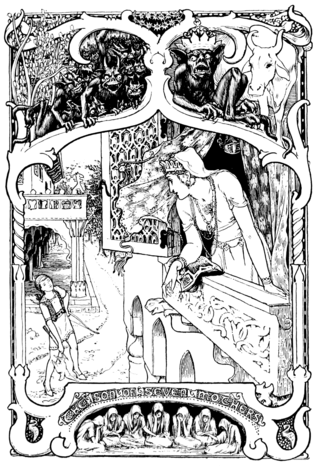Related Research Articles

"Iron John" is a German fairy tale found in the collections of the Brothers Grimm, tale number 136, about an iron-skinned wild man and a prince. The original German title is Eisenhans, a compound of Eisen "iron" and Hans. It represents Aarne–Thompson type 502, "The wild man as a helper".

"The Devil with the Three Golden Hairs" is a German fairy tale collected by the Brothers Grimm. It falls under Aarne–Thompson classification types 461, and 930.
The Golden Crab is a Greek fairy tale collected as "Prinz Krebs" by Bernhard Schmidt in his Griechische Märchen, Sagen and Volkslieder. Andrew Lang included it in The Yellow Fairy Book.
Fair, Brown and Trembling is an Irish fairy tale collected by Jeremiah Curtin in Myths and Folk-lore of Ireland and Joseph Jacobs in his Celtic Fairy Tales.
The Armless Maiden is a Russian fairy tale collected by Alexander Afanasyev in Narodnye russkie skazki.
The Hairy Man is a Russian fairy tale. Andrew Lang included it in The Crimson Fairy Book.
The Prince Who Worked as Satan's Servant and Saved the King from Hell is a Lithuanian fairy tale collected by German linguists August Leskien and Karl Brugmann. Andrew Lang included it in The Grey Fairy Book under the title The Magician's Horse.

The Golden Lion is an Italian fairy tale collected by Laura Gonzenbach in Sicilianische Märchen. Andrew Lang included it in The Pink Fairy Book.

"The Water of Life" is a German fairy tale collected by the Brothers Grimm, tale number 97.
The Snake Prince is an Indian fairy tale, a Punjabi story collected by Major Campbell in Feroshepore. Andrew Lang included it in The Olive Fairy Book (1907).
The Blue Belt is a Norwegian fairy tale collected by Peter Christen Asbjørnsen and Jørgen Moe in Norske Folkeeventyr. It is Aarne-Thompson type 590.
Penta of the Chopped-off Hands or The Girl With the Maimed Hands is an Italian literary fairy tale written by Giambattista Basile in his 1634 work, the Pentamerone.
The "Tale of the Doomed Prince" is an ancient Egyptian story, dating to the 18th Dynasty, written in hieratic text, which survived partially on the verso of Papyrus Harris 500 currently housed in the British Museum. The papyrus was burned in an explosion; because of this damage the conclusion of the story is missing. Some scholars speculate that the missing ending was mostly likely a happy one and that the tale could be more aptly named "The Prince who was Threatened by Three Fates" or the like.

Ileana Simziana or Ileana Sînziana is a Romanian fairy tale collected and written down by Petre Ispirescu between 1872 and 1886. It tells the story of an unnamed youngest daughter of an emperor, who dresses up as a man, goes to serve another emperor and rescues the titular princess Ileana. During a quest of obtaining the Holy Water she is hit by a curse of a monk that causes her to transform into a man - Făt-Frumos, who marries Ileana in the happy ending.

King Lindworm or Prince Lindworm is a Danish fairy tale published in the 19th century by Danish folklorist Svend Grundtvig.

Adventures of Gilla Na Chreck An Gour is an Irish fairy tale collected by folklorist Patrick Kennedy and published in Legendary Fictions of the Irish Celts (1866). The tale was also published by Irish poet Alfred Perceval Graves in his Irish Fairy Book (1909). Joseph Jacobs published the tale as The Lad with the Goat-Skin in his Celtic Fairy Tales.

The Son of Seven Mothers or The Son of Seven Queens is an Indian folktale, first published in the late 19th century by author Flora Annie Steel. It is classified in the international Aarne-Thompson-Uther Index as ATU 462, "The Outcast Queens and the Ogress Queen".
Princess Aubergine is an Indian folktale collected by Flora Annie Steel and sourced from the Punjab region. It concerns a princess whose lifeforce is tied to a necklace, and, as soon as it falls in the hand of a rival, the princess falls into a death-like sleep - comparable to heroines of European fairy tales Snow White and Sleeping Beauty. Variants exist in India, both with a heroine and a hero whose life is attached to a magical necklace.
Donotknow is a Russian fairy tale (skazka) collected by folklorist Alexandr Afanasyev in his three-volume compilation Russian Fairy Tales. The tale was also translated as "Know Not" by Jack V. Haney.

Kiranmala is a Bengali folktale collected by author Dakshinaranjan Mitra Majumder and published in the compilation Thakurmar Jhuli, a collection of Bengali folk tales and fairy tales.
References
- ↑ Andrew Lang, The Brown Fairy Book, "The King Who Would Be Stronger Than Fate"
- ↑ Thompson, Stith. The Folktale. University of California Press. 1977. pp. 205-207. ISBN 0-520-03537-2
- ↑ Čechová, Mariana; Klimková, Simona. Studi Slavistici; Florence Vol. 16, (2019): 77-89. DOI:10.13128/Studi_Slavis-7474